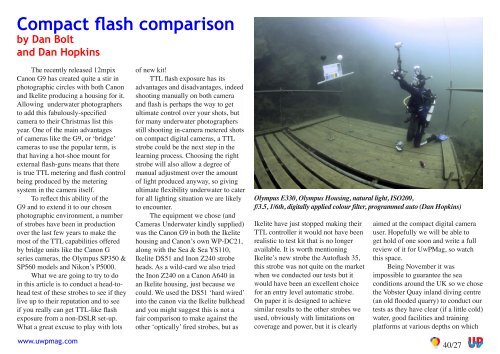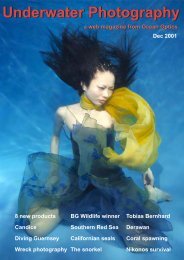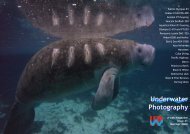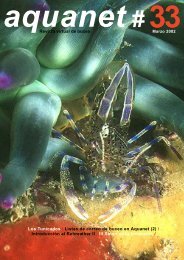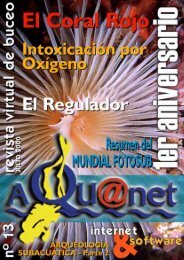Underwater Photography Underwater Photography
Underwater Photography Underwater Photography
Underwater Photography Underwater Photography
Create successful ePaper yourself
Turn your PDF publications into a flip-book with our unique Google optimized e-Paper software.
Compact flash comparison<br />
by Dan Bolt<br />
and Dan Hopkins<br />
The recently released 12mpix<br />
Canon G9 has created quite a stir in<br />
photographic circles with both Canon<br />
and Ikelite producing a housing for it.<br />
Allowing underwater photographers<br />
to add this fabulously-specified<br />
camera to their Christmas list this<br />
year. One of the main advantages<br />
of cameras like the G9, or ‘bridge’<br />
cameras to use the popular term, is<br />
that having a hot-shoe mount for<br />
external flash-guns means that there<br />
is true TTL metering and flash control<br />
being produced by the metering<br />
system in the camera itself.<br />
To reflect this ability of the<br />
G9 and to extend it to our chosen<br />
photographic environment, a number<br />
of strobes have been in production<br />
over the last few years to make the<br />
most of the TTL capabilities offered<br />
by bridge units like the Canon G<br />
series cameras, the Olympus SP 50 &<br />
SP5 0 models and Nikon’s P5000.<br />
What we are going to try to do<br />
in this article is to conduct a head-tohead<br />
test of these strobes to see if they<br />
live up to their reputation and to see<br />
if you really can get TTL-like flash<br />
exposure from a non-DSLR set-up.<br />
What a great excuse to play with lots<br />
www.uwpmag.com<br />
of new kit!<br />
TTL flash exposure has its<br />
advantages and disadvantages, indeed<br />
shooting manually on both camera<br />
and flash is perhaps the way to get<br />
ultimate control over your shots, but<br />
for many underwater photographers<br />
still shooting in-camera metered shots<br />
on compact digital cameras, a TTL<br />
strobe could be the next step in the<br />
learning process. Choosing the right<br />
strobe will also allow a degree of<br />
manual adjustment over the amount<br />
of light produced anyway, so giving<br />
ultimate flexibility underwater to cater<br />
for all lighting situation we are likely<br />
to encounter.<br />
The equipment we chose (and<br />
Cameras <strong>Underwater</strong> kindly supplied)<br />
was the Canon G9 in both the Ikelite<br />
housing and Canon’s own WP-DC21,<br />
along with the Sea & Sea YS110,<br />
Ikelite DS51 and Inon Z240 strobe<br />
heads. As a wild-card we also tried<br />
the Inon Z240 on a Canon A 40 in<br />
an Ikelite housing, just because we<br />
could. We used the DS51 ‘hard wired’<br />
into the canon via the Ikelite bulkhead<br />
and you might suggest this is not a<br />
fair comparison to make against the<br />
other ‘optically’ fired strobes, but as<br />
Olympus E330, Olympus Housing, natural light, ISO200,<br />
f/3.5, 1/6th, digitally applied colour filter, programmed auto (Dan Hopkins)<br />
Ikelite have just stopped making their<br />
TTL controller it would not have been<br />
realistic to test kit that is no longer<br />
available. It is worth mentioning<br />
Ikelite’s new strobe the Autoflash 35,<br />
this strobe was not quite on the market<br />
when we conducted our tests but it<br />
would have been an excellent choice<br />
for an entry level automatic strobe.<br />
On paper it is designed to achieve<br />
similar results to the other strobes we<br />
used, obviously with limitations on<br />
coverage and power, but it is clearly<br />
aimed at the compact digital camera<br />
user. Hopefully we will be able to<br />
get hold of one soon and write a full<br />
review of it for UwPMag, so watch<br />
this space.<br />
Being November it was<br />
impossible to guarantee the sea<br />
conditions around the UK so we chose<br />
the Vobster Quay inland diving centre<br />
(an old flooded quarry) to conduct our<br />
tests as they have clear (if a little cold)<br />
water, good facilities and training<br />
platforms at various depths on which<br />
40/27


